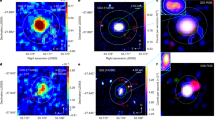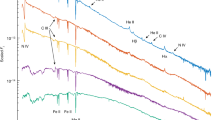Abstract
SEVERAL investigators have described the features around the galactic centre in some infrared wavelength regions1–3. Their results demonstrate the conspicuous peak and several humps around it. These observations, however, are confined to a rather small region mainly because of the terrestrial background radiation. So the overall feature of the central bulge of our Galaxy could not be derived. Studies of the central bulge have been carried out only with the aid of the distribution of RR Lyrae variables through the ‘galactic window’4, but the distribution does not necessarily represent that of general stars which are responsible for the galactic structure. On the contrary, near infrared observation reveals the structure of the central bulge more directly, because the main constituents of the bulge are probably late-type stars which radiate their energy effectively in the infrared region, as inferred from external galaxies. Much weaker interstellar extinction in the infrared region also enables us to observe the whole central bulge through thick interstellar dust clouds. The surface brightness at 2.4 µm in the range of 75° > l > 23°, |b| <20° was attained by our previous balloon experiment5,6. We have now attempted further similar observations aiming mainly to derive the surface brightness of the central bulge of our Galaxy.
This is a preview of subscription content, access via your institution
Access options
Subscribe to this journal
Receive 51 print issues and online access
$199.00 per year
only $3.90 per issue
Buy this article
- Purchase on Springer Link
- Instant access to full article PDF
Prices may be subject to local taxes which are calculated during checkout
Similar content being viewed by others
References
Becklin, E. E., and Neugebauer, G., Astrophys. J., 151, 145 (1968).
Hoffmann, W. F., Frederick, C. L., and Emery, R. J., Astrophys. J. Lett., 164, L23 (1971).
Rieke, G. H., and Low, F. J., Astrophys. J., 184, 415 (1973).
Oort, J. H., and Plant, L., Astr. Astrophys., 41, 71 (1975).
Hayakawa, S., Ito, K., Matsumoto, T., Ono, T., and Uyama, K., Nature, 261, 29 (1976).
Ito, K., Matsumoto, T., and Uyama, K., Publ. Astron. Soc. Japan., 28, No. 3 (in the press).
Kodaira, K., Tanaka, W. W., Onaka, T., Nagai, T., Watanabe, T., and Suemoto, Z., Tokyo astr. Bull., 2nd Ser., No. 245, 2077 (1976).
Price, S. D., Astron. J., 73, 431 (1968).
Author information
Authors and Affiliations
Rights and permissions
About this article
Cite this article
ITO, K., MATSUMOTO, T. & UYAMA, K. Infrared profile of central region of our Galaxy at 2.47 µm. Nature 265, 517–518 (1977). https://doi.org/10.1038/265517a0
Received:
Accepted:
Issue Date:
DOI: https://doi.org/10.1038/265517a0
This article is cited by
-
Galactic structure from the Two Micron Galactic Survey
Astrophysics and Space Science (1994)
-
The distribution of infrared sources in the galactic plane
Astrophysics and Space Science (1981)
-
Near IR surface brightness of southern galactic plane
Nature (1979)
Comments
By submitting a comment you agree to abide by our Terms and Community Guidelines. If you find something abusive or that does not comply with our terms or guidelines please flag it as inappropriate.



